This page covers all the Cyprus euro coins. The Cypriot euro coins are also part of the Euro coins collection, we will go to see the characteristics, value and rarity of each coin.
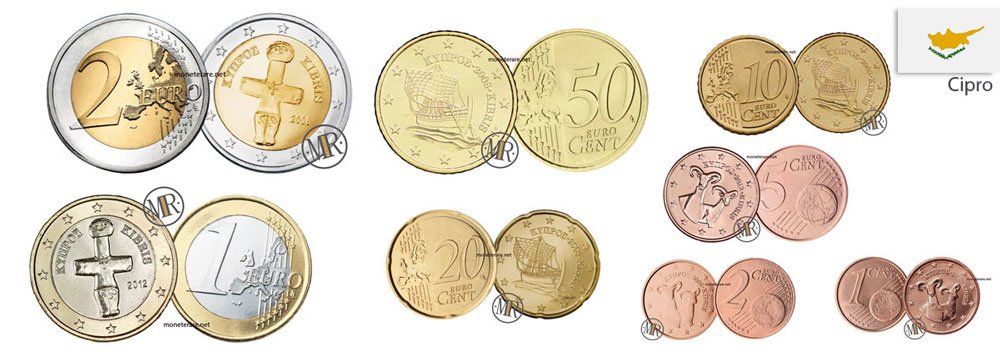
Introduction
On the island of Cyprus, euro coins are adopted for the first time on 1 January 2008, four years after the official entry as a member of the European Union. Obviously preceded by the ERM II agreement, which aims to maintain the stability of exchange rates between the euro and the previous currency, on May 2, 2005.
To underline the importance of this event, the Central Bank of Cyprus commissioned two designers to design the back of the coins. The two artists are the Greek artist Tatiana Soteropoulos and the American Erik Maell. The final product was then exhibited and presented on October 10, 2006 in an exhibition, also set up by the Central Bank of Cyprus, as it was set up to tell the story of the island’s currency.
This coins have no tick marks.
They were minted for the first time by the Finnish Mint, Vantaa from 2008 to 2009, followed by the Greek Mint Halandri, precisely from 2010 to 2018.
1 Cent Cyprus Euro Coins
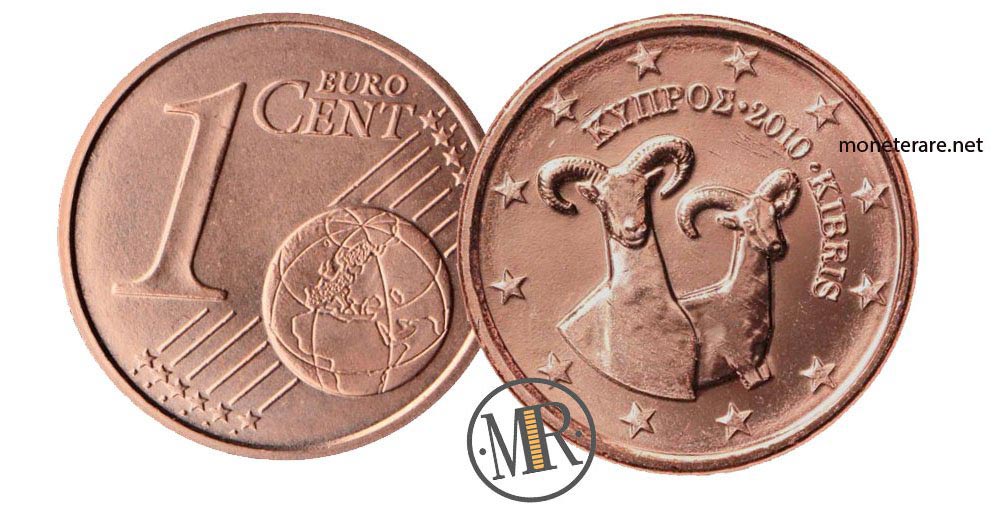
The reverse shows the common face of all the states belonging to the Euro Zone.
The National Face characterizes the obverse Face, with the same design engraved on all the “red” cents of Cyprus. In the centre of the 1 Euro cent coin from Cyprus, there is a pair of mouflons watching us.
The first mouflon is portrayed frontally, unlike the second, which has its face turned slightly to the right. The choice to represent these animals on the national currency was made as it is the most characteristic species of protected fauna in this country.
Another peculiarity, which is present in all coins, is the presence of the national symbol, ie the Greek name of the island followed by the thousandth of minting and the Turkish name of Cyprus: ΚΥΠΡΟΣ thousandth KIBRIS.
The inscription with the emblem is placed at the top right in a semicircle. Finally, the engraving is enclosed by 12 five-pointed stars, placed on the outer edge, which represent the European Union.
- Materials: Copper-plated steel ( steel 94,35 % and copper 5,65 %)
- Thickness: 1.67 mm
- Weight: 2.3 g
- Diameter: 16.5 mm
- Outline: Smooth
- Engraver: Erik Maell and Tatiana Soteropoulos
Value and Circulation of 1 Cent Cyprus Euro Coins
2 Cents Cyprus Euro Coins
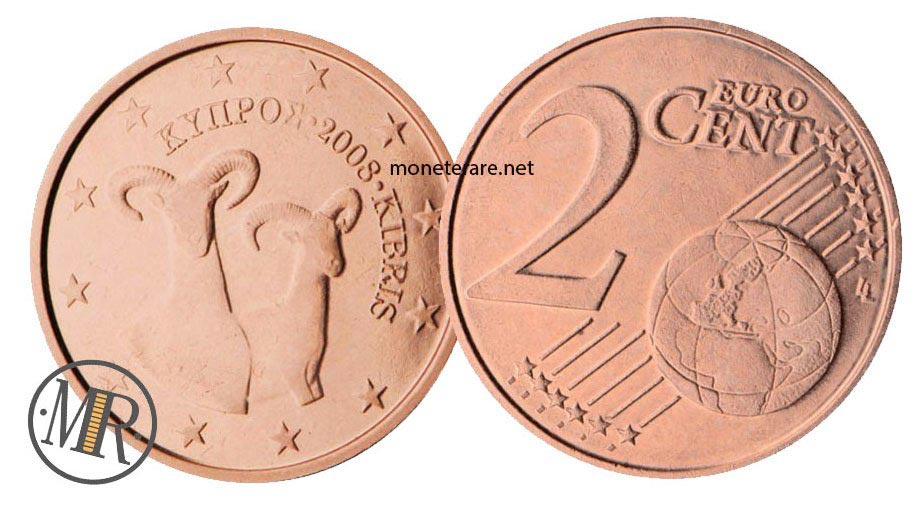
So, as mentioned before, the 2 Cents Cyprus Euro Coins have the same design and finish as the 1-Cyprus cent coin.
In the reverse is represented the Common Face, as for all the European states of the Eurocollection.
In the National Face, on the obverse, there is a pair of mouflons, as for the coins of 1 and 5 cents of Cyprus. The mouflon represented frontally in foreground, has the look turned toward us, the other instead is slightly turned toward right, however its look is always turned toward us.
This pair of animals, considered a protected species on the Island, is enclosed by a circle of 12 five-pointed stars, which can only represent the European Union.
The inscription ΚΥΠΡΟΣ thousandth KIBRIS dominates above the head of the animals.
- Materials: Copper-plated steel ( steel 94,35 % and copper 5,65 %)
- Thickness: 1, 67 mm
- Weight: 3.06 g
- Diameter: 18.75 mm
- Outline: Incused horizontal thread
- Engraver: Erik Maell and Tatiana Soteropoulos
Value and Circulation of 2 Cents Cyprus Euro Coins
5 Cents Cyprus Euro Coins
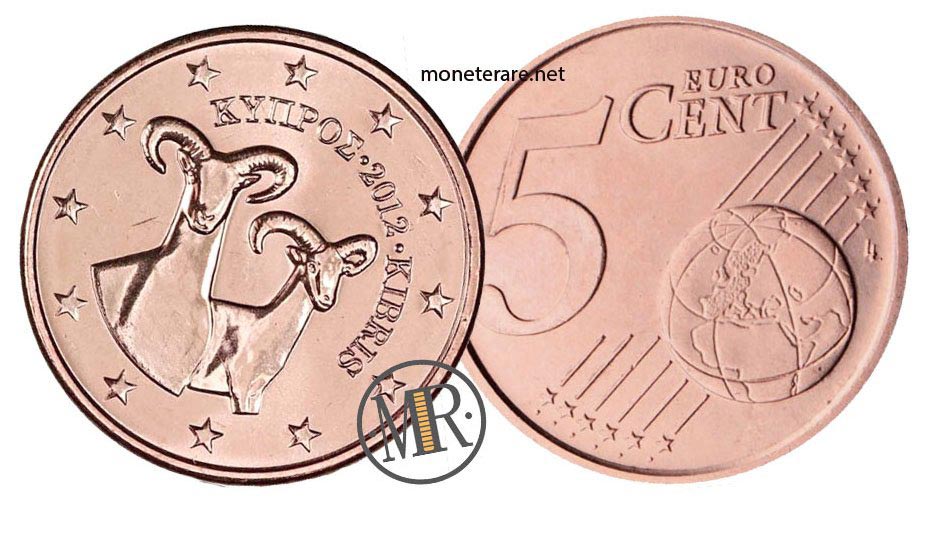
The reverse is represented by the Common Face of all the countries of the Euro zone.
In the Obverse, as for the coins of 1 and 2 cents of Cyprus, are represented the two Mouflons, placed in the center of the coin.
Around the engraving of the mouflons there is a circle of 12 5-pointed stars. On the right of the protected species is engraved the inscription ΚΥΠΡΟΣ thousandth KIBRIS, name of the island in Greek, followed by the thousandth of minting and the name of Cyprus, in Turkish.
- Materials: Copper-plated steel ( steel 94,35 % and copper 5,65 %)
- Thickness: 1.67 mm
- Weight: 3.06 g
- Diameter: 21.25 mm
- Outline: Smooth
- Engraver: Erik Maell and Tatiana Soteropoulos
Value and Circulation of 5 Cents Cyprus Euro Coins
10 Cents Cyprus Euro Coins
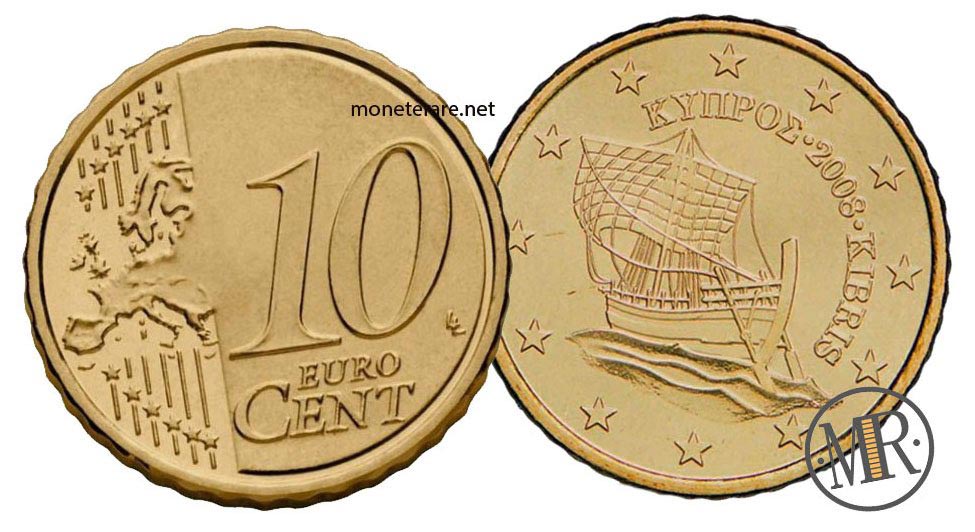
Here we now come to the description of the 10 cents Cyprus Euro Coins. As with the red cents, all three yellow cents have the same design.
The verse is that of the Common face of all the 10 cents of the Euro in the eurozone.
The obverse of the Cypriot Euro Coin of 10 cents is characterized by the representation of the ship of Kyrenia, sailing from right to left (ship of the fourth century BC). This image was chosen to crown the link with the sea, which has always been a source of resources for the inhabitants of the island.
In fact, thanks to its strategic position, which sees it overlooking the Mediterranean Sea, has always been able to enjoy advantages for all commercial and maritime activities.
Surrounding the representation of the ship there are 12 five-pointed stars, symbol of the European Union, which in fact defines its membership.
Between the ship of Kyrenia and the 12 stars, there is placed the national symbol of the island of Cyprus. The inscription, ΚΥΠΡΟΣ thousandth KIBRIS, has two distinct idioms, namely Greek and Turkish, divided by the thousandth of minting
- Materials: Nordic Gold ( copper 89% – aluminium 5 % – zinc 5 % – tin 1 % )
- Thickness: 1.93 mm
- Weight: 4.1 g
- Diameter: 19.75 mm
- Outline: Rowed with thick knurling
- Engraver: Erik Maell and Tatiana Soteropoulos
Value and Circulation of 10 Cents Cyprus Euro Coins
20 Cents Cyprus Euro Coins
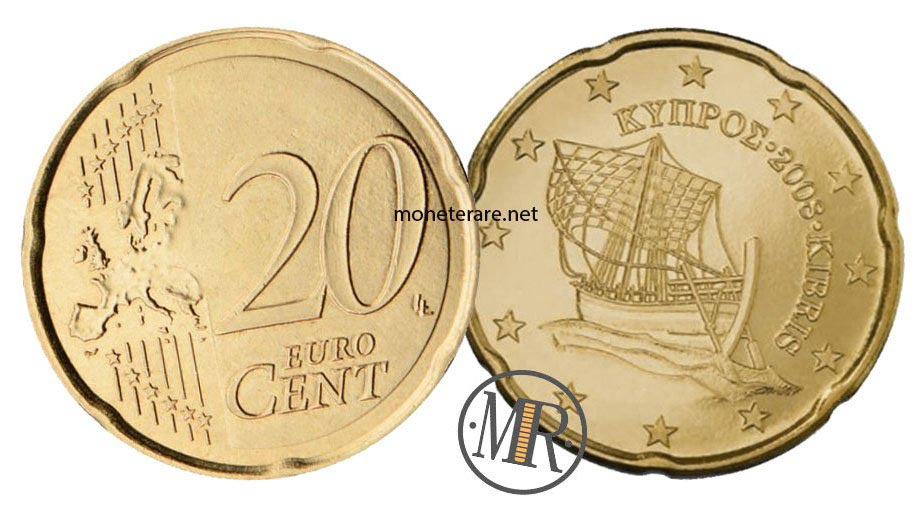
Also the Cypriot 20 euro cents reverse is the common one for all the countries belonging to the Euro zone.
In the Front of the 20 cents Euro Cyprus, we find the same design of the 10 and 50 cents of the island Cyprus, the ship of Kyrenia sailing.
The ship of Kyrenia today is the wreck of a merchant ship of the fourth century BC, famous for having sailed the seas under the rule of Alexander the Great. Rediscovered in 1967, it is now located in Kyrenia Castle, in the Turkish Republic of Northern Cyprus.
The coin depicts her sailing to the left as she sails the waves.
The coin is decorated with 12 five-pointed stars and a symbol of the European Union.
Between the representation of the ship and the circle of stars, there are two words written in different languages ΚΥΠΡΟΣ thousandth KIBRIS. The words are engraved in Greek and Turkish respectively and refer to the name of the island of Cyprus.
The fact of the bilingual and the choice of Greek and Turkish, is due to the very division of the island. In fact, it is divided into the Greek-Cypriot Republic of Cyprus and the self-proclaimed Turkish Republic of Northern Cyprus.
The situation of tension between the two sides, which has not yet been resolved, has always been recognised.
- Materials: Nordic Gold ( copper 89% – aluminium 5 % – zinc 5 % – tin 1 % )
- Thickness: 2.14 mm
- Weight: 5.74 g
- Diameter: 22.25 mm
- Outline: Wide knurling
- Engraver: Erik Maell and Tatiana Soteropoulos
Value and Circulation of 20 Cents Cyprus Euro Coins
50 Cents Cyprus Euro Coins
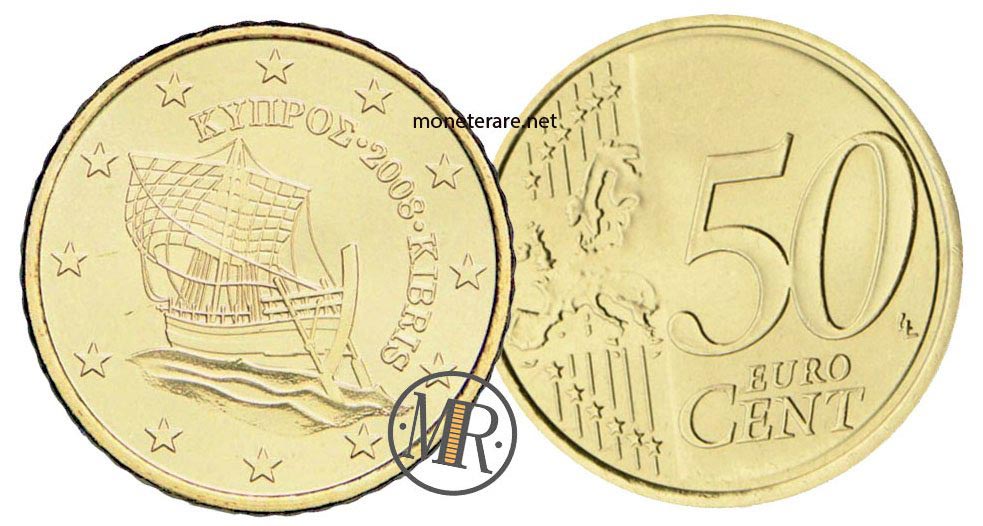
The last “yellow” coin on which the design in the Ship of Kyrenia is shown is the 50 cent Cyprus Euro coins.
In the reverse is engraved the common face of the countries that have joined the euro zone.
The Obverse has at the base of the design three waves that visually represent the movement of the sea. Waves that are ploughed by the ship, of which today there is only a wreck, which from the right navigates to the left.
The inscription ΚΥΠΡΟΣ thousandth KIBRIS is the national symbol of the island of Cyprus, or the name of the island in Greek and Turkish, divided only by the thousandth of minting.
- Materials: Nordic Gold ( copper 89% – aluminium 5 % – zinc 5 % – tin 1 % )
- Thickness: 2.38 mm
- Weight: 7.80 g
- Diameter: 24.25 mm
- Outline: Rowed with thick knurling
- Engraver: Erik Maell and Tatiana Soteropoulos
Value and Circulation of 50 Cents Cyprus Euro Coins
1 Euro Cypriot Coins

After the pennies, we finally get to the bimetallic coins. Even the Cypriot 1 euro coin shows a drawing rich in history.
The reverse is the one common to all the 1 Euro coins of the Euro zone.
In the obverse, in the center, was reported an idol in the shape of a cross dating from the Chalcolithic period (3000 BC) which comes from the village of Promos, a typical example of prehistoric art of Cyprus.
The idol is inspired by a sculpture exhibited at the Cypriot National Museum of Nicosia. This sculpture represents a woman with open arms, thought to be a symbol of fertility. At the neck the idol is hung in turn another idol, obviously smaller in size. This is because at the time it was widespread its use as an ornament.
On the outer edge, of different color with respect to the central part of the coin, there are 12 five-pointed stars, symbol of the European Union.
Under the right arm of the depicted woman there is the thousandth of minting and at the sides of the head, respectively on the left and on the right, there are two inscriptions in bilingual ΚΥΠΡΟΣ – KIBRIS that indicate the name of the island in Greek and Turkish.
- Materials: Bimetallic. Outer part: nickel brass ( copper 75% – zinc 20% – nickel 5 % ); inner part: copper-nickel (copper 75 % – nickel 25 % )
- Thickness: 2.33 mm
- Weight: 7.5 g
- Diameter: 23.25 mm
- Outline: Discontinuously grooved
- Engraver: Erik Maell and Tatiana Soteropoulos
Value and Circulation of Cypriot 1 Euro Coins
2 Euro Cypriot Coins
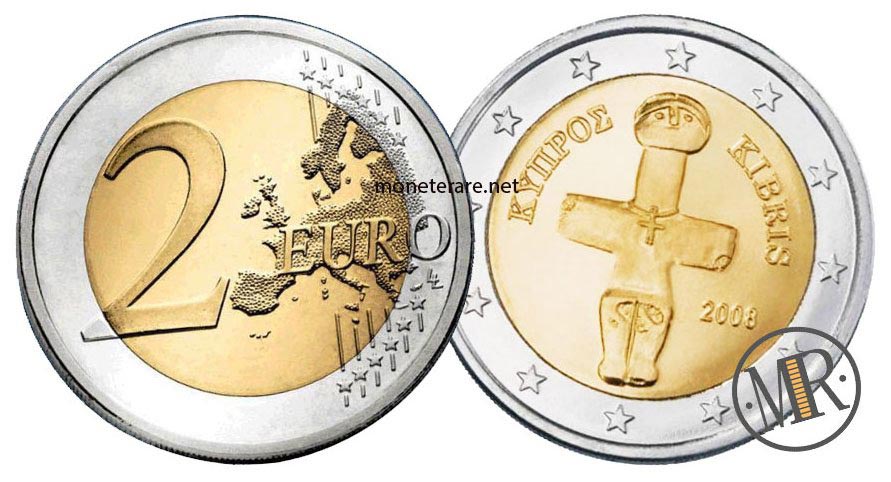
Bimetallic coin like the 1 euro coin, the reverso is the common face of all the 2 euro coins of the Euro Zone countries. Remember to look up the Cypriot commemorative 2 euro coins that can have a higher value.
Obverse: As with the 1 euro coin, the 2 euro Cyprus coin also depicts the idol, a fertile woman with open arms stylized in the shape of a cross.
The Greek name of the island and the Turkish name of Cyprus (ΚΥΠΡΟΣ – KIBRIS) are engraved on the right and left sides of the head of the figure, in the upper semicircle, respectively. Unlike the centesimi, in which the thousandth of minting was reported between the two writings, in the coins of 1 and 2 euro is reported under the right arm of the woman.
On the outside, on the edge, are depicted 12 five-pointed stars and the symbol of the European Union.
The 2 Euro coin was the only coin chosen to commemorate the 10th Anniversary of the Economic and Monetary Union. For the occasion, the straight design was replaced by a stylized figure chosen through an online competition.
- Materials: Bimetallic. Inner part: copper-nickel (copper 75 % – nickel 25 % ); outer part: nickel brass (copper 75 % – zinc 20 % – nickel 5 % )
- Thickness: 2,20 mm
- Weight: 8.5 g
- Diameter: 25.75 mm
- Outline: Finely knurled with the pattern ” 2 ΕΥΡΩ 2 EURO ” repeated twice
- Engraver: Erik Maell and Tatiana Soteropoulos
Value and Circulation of Cypriot 2 Euro Coins
Do you want to learn more about Euro Coins?
- Two pages you can’t miss: 2 Euro Commemorative Coins and Rare Euro Coins
- The precious Vatican euro coins can be seen here and also the San Marino euro coins
- Here you can see the Malta euro coins and here the Cyprus euro coins.
- Euro coins from Germany can be found here and Euro coins from Estonia and Latvia Euro Coins here.
- Euro coins from France can be found here, as well as Euro coins from Austria.
- Also of great interest are the euro coins from Greece and the euro coins of Luxembourg.
- Here you will find Lithuania Euro coins and Andorra Euro coins
- We also talked about Slovenian Euro coins and Slovakia Euro coins.
- Check also Spanish Euro Coins here and Euro Coins of Portugal here.
- The Netherlands euro coins can be found here and the Ireland euro coins here.
- All precious Monaco Euro coins are here and Belgium Euro coins here


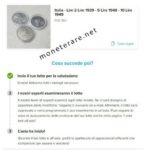
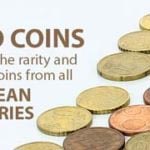
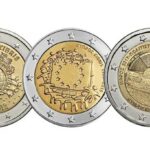
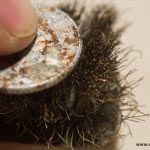
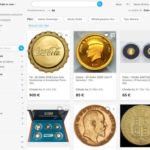
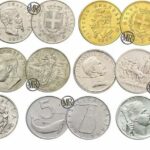
Hi There
My name is Antonis
I have a lot of different rare euro coins that I’ve been collecting for years and I’m interested in finding a certified to accurate the value of these coins before I sell them